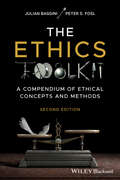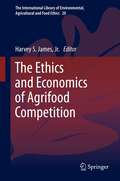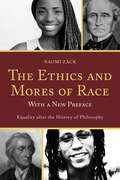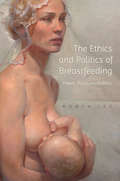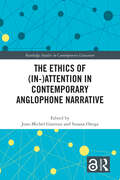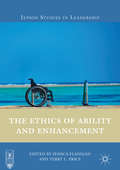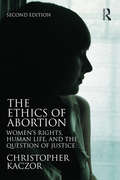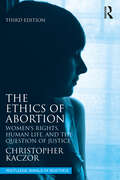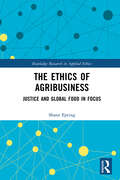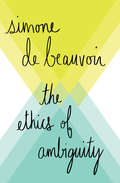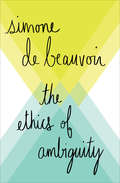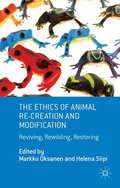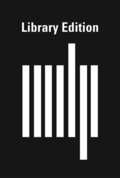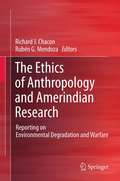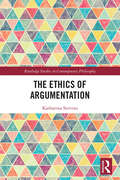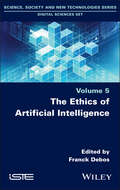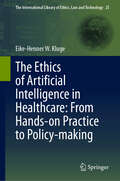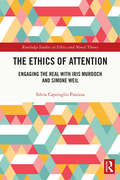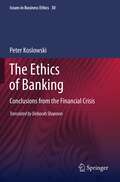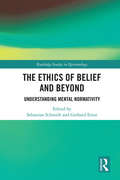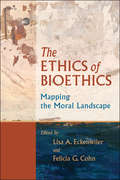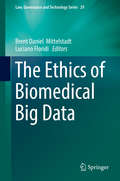- Table View
- List View
The Ethics Toolkit: A Compendium of Ethical Concepts and Methods
by Julian Baggini Peter S. FoslA new edition of the bestselling guide which equips readers with the skills necessary for engaging in ethical reflection The Ethics Toolkit offers an engaging and approachable introduction to the core concepts, principles, and methods of contemporary ethics. Explaining to students and general readers how to think critically about ethics and actually use philosophical concepts, this innovative volume provides the tools and knowledge required to engage intelligently in ethical study, deliberation, and debate. Invaluable as both a complete guide and a handy reference, this versatile resource provides clear and authoritative information on a diverse range of topics, from fundamental concepts and major ethical frameworks to contemporary critiques and ongoing debates. Throughout the text, Fosl and Baggini highlight the crucial role ethics plays in our lives, exploring autonomy, free will, consciousness, fairness, responsibility, consent, intersectionality, sex and gender, and much more. Substantially revised and expanded, the second edition of The Ethics Toolkit contains a wealth of new entries, new recommended readings, more detailed textual references, and numerous timely real-world and hypothetical examples. Uses clear and accessible language appropriate for use inside and beyond the classroom Contains cross-referenced entries to help readers connect and contrast ideas Engages both non-Western and Western philosophy Offer insights into key issues in ethics with a firm grounding in the history of philosophy Includes an appendix of tools for the practice of ethics, including links to podcasts, web and print resources, and prominent ethics organizations Written by the authors of the popular The Philosophers’ Toolkit, this new edition of The Ethics Toolkit is a must-have resource for anyone interested in ethics, from general readers to undergraduate and graduate students.
The Ethics and Economics of Agrifood Competition
by Harvey S. James Jr.This edited volume presents ethical and economic analyses of agrifood competition. By systematically examining fairness and openness in agricultural markets, it seeks to answer the question of whether there is adequate competition in the agrifood industry and whether the system is fair to all participants. It outlines ethical and economic principles important for understanding agrifood competition, presents arguments for and against consolidation, globalization and the integration of agrifood industries, and looks at the implications of globalization on the nature of competition in specific agricultural contexts.
The Ethics and Mores of Race: Equality after the History of Philosophy
by Naomi Zack<p>Preeminent philosopher, Naomi Zack, brings us an indispensable work in the ethics of race through an inquiry into the history of moral philosophy. Beginning with Plato and a philosophical tradition that has largely ignored race, The Ethics and Mores of Race: Equality after the History of Philosophy enters into a web of ideas, ethics, and morals that untangle our evolving ideas of racial equality straight into the twenty-first century. The dichotomy between ethics and mores has long aided the separation of what is right with ideas of equality. Zack tackles the co-existence of slavery with the classic moral systems and continues to show how our society has evolved and our mores with it. An ethics of race may not exist yet, but this book gives us twelve discerning requirements to establish it. <p>In the preface to the paperback edition, Zack addresses the criticisms raised in response to this book and concludes that a focus on rights and justice, rather than privilege, is the only fruitful pathway towards a functioning ethics of race. </p>
The Ethics and Politics of Breastfeeding: Power, Pleasure, Poetics
by Robyn LeeResponding to the most widely read breastfeeding manual, La Leche League’s The Womanly Art of Breastfeeding, Robyn Lee’s The Ethics and Politics of Breastfeeding explores breastfeeding as an art that must be developed through skillful application of effort and distinguished from a merely natural or physiological process. The Ethics and Politics of Breastfeeding challenges the dominant understanding of breastfeeding and cultivates an alternative conception as an ethical, embodied practice of the self. Drawing on the work of Michel Foucault, Emmanuel Levinas, and Luce Irigaray, Lee develops a new understanding of breastfeeding as an "art of living," where the practice is reconsidered in the light of ongoing social inequalities.
The Ethics of (Routledge Studies in Contemporary Literature)
by Susana Onega Jean-Michel GanteauThis volume argues that contemporary narratives evince a great deal of resilience by promoting an ecology of attention based on poetic options that develop an ethics of the particularist type. The contributors draw on critical and theoretical literature hailing from various fields: including psychology and sociology, but more prominently phenomenology, political philosophy, analytical philosophy (essentially Ordinary Language Philosophy), alongside the Ethics of Care and Vulnerability. This volume is designed as an innovative contribution to the nascent field of the study of attention in literary criticism, an area that is full of potential. Its scope is wide, as it embraces a great deal of the Anglophone world, with Britain, Ireland, the USA, but also Australia and even Malta. Its chapters focus on well-established authors, like Kazuo Ishiguro (whose work is revisited here in a completely new light) or more confidential ones like Melissa Harrison or Sarah Moss.Chapter 2 of this book is freely available as a downloadable Open Access PDF at http://www.taylorfrancis.com under a Creative Commons [Attribution-Non Commercial-No Derivatives (CC-BY-NC-ND)] 4.0 license.
The Ethics of Ability and Enhancement
by Terry L. Price Jessica FlaniganThis book explores our ethical responsibilities regarding health in general and disabilities in particular. Disability studies and human enhancement stand out as two emerging areas of research in medical ethics, prompting debates into ethical questions of identity, embodiment, discrimination, and accommodation, as well as questions concerning distributive justice and limitations on people's medical rights. Edited by two ethicist philosophers, this book combines their mastery of the theoretical debates surrounding disability and human enhancement with attention to real world questions that health workers and patients may face. By including a wide range of high-quality voices and perspectives, the book provides an invaluable resource for scholars who are working on this important and emerging area of leadership and health care ethics.
The Ethics of Abortion: Women’s Rights, Human Life, and the Question of Justice (Routledge Annals of Bioethics)
by Christopher KaczorAppealing to reason rather than religious belief, this book is the most comprehensive case against the choice of abortion yet published. This Second Edition of The Ethics of Abortion critically evaluates all the major grounds for denying fetal personhood, including the views of those who defend not only abortion but also post-birth abortion. It also provides several (non-theological) justifications for the conclusion that all human beings, including those in utero, should be respected as persons. This book also critiques the view that abortion is not wrong even if the human fetus is a person. The Ethics of Abortion examines hard cases for those who are prolife, such as abortion in cases of rape or in order to save the mother’s life, as well as hard cases for defenders of abortion, such as sex selection abortion and the rationale for being "personally opposed" but publically supportive of abortion. It concludes with a discussion of whether artificial wombs might end the abortion debate. Answering the arguments of defenders of abortion, this book provides reasoned justification for the view that all intentional abortions are ethically wrong and that doctors and nurses who object to abortion should not be forced to act against their consciences. Updates and Revisions to the Second Edition include: -A response to Alberto Giubilini’s and Francesca Minerva’s now famous 2012 article, "After-Birth Abortion" in the Journal of Medical Ethics -Responses to new defenses of Judith Jarvis Thomson’s violinist argument -The addition of a new chapter on gradualist views of fetal moral worth, including Jeff McMahan’s Time-Relative Interest Account -The addition of a new chapter on the conscience protection for health care workers who are opposed to abortion -Responses to many critiques of the first edition, including those made by Donald Marquis, David DeGrazia, and William E. May
The Ethics of Abortion: Women’s Rights, Human Life, and the Question of Justice (Routledge Annals of Bioethics)
by Christopher KaczorThe overturning of Roe v Wade makes the ethical consideration of abortion more important than ever. Appealing to reason rather than religious belief, this book is the most comprehensive case against the choice of abortion yet published. This third edition of The Ethics of Abortion critically evaluates all the major grounds for denying basic rights to fetal human beings, including the views of those who defend not only abortion but also post-birth abortion. It also provides several (non-theological) justifications for the conclusion that all human beings, including those in utero, should be respected as persons. This book also critiques the view that abortion is not wrong even if the human fetus is a person. The Ethics of Abortion examines hard cases for those who are prolife, such as abortion in cases of rape or in order to save the woman's life, as well as hard cases for defenders of abortion, such as sex selection abortion and the rationale for being "personally opposed" but publicly supportive of abortion. It concludes with a discussion of whether artificial wombs might end the abortion debate. Answering the arguments of defenders of abortion, this book provides reasoned justification for the view that all intentional abortions are ethically wrong and that doctors and nurses who object to abortion should not be forced to act against their consciences. Updates and Revisions to the Third Edition Include: Discusses Achas Burin’s 2014 essay, "Beyond Pragmatism: Defending the ‘Bright Line’ of Birth" in chapter 3 Incorporates into chapter 8 David Boonin’s cogently argued 2019 book, Beyond Roe: Why Abortion Should be Legal – Even if the Fetus is a Person Expands chapter 9 to examine tragic cases in which prenatal diagnosis determines with certainty that a fetus will die shortly after birth Includes an updated and expanded section in chapter 11 on recent debates about conscience protections Considers in chapter 12 recent arguments that parents have a right to kill if the product of conception is in an artificial womb Updates statistics on numbers of abortions in the United States, including corrections to statistics that were once thought true but are now known as erroneous Updated bibliography
The Ethics of Agribusiness: Justice and Global Food in Focus (Routledge Research in Applied Ethics)
by Shane EptingThis book offers an original perspective on food supply chains. It argues that the ability to trade food on a global scale could be intrinsically good aside from any instrumental value that people gain from it. While the author’s argument seems to counter wholesale anti-agribusiness views, it is consistent with the larger goals of food-justice movements. The author examines the structures of food supply chains, revealing the kinds of harm they help produce. They include slavery, abusive labor, geopolitical exploitation, ecological degradation, and public health impacts. Although the book argues that food supply chains can be collectively beneficial, eliminating their immoral features must hold steady as a continuous enterprise. Securing this outcome means that we go beyond critique. The final chapter advocates for the sustainable food label to address issues of food justice and food sovereignty. The Ethics of Agribusiness will interest researchers and advanced students working in food ethics, environmental ethics, and agricultural ethics.
The Ethics of Ambiguity
by Simone De BeauvoirBy exploring the meaning of "existence before essence" and the basic reality of choice, Beauvoir presents the reader with existentialism. Ethics is both succinct and poetic, maintaining a clearness that Being and Nothingness lacks.
The Ethics of Ambiguity
by Simone De BeauvoirIn de Beauvoir's second major essay, the renowned French philosopher illustrates the ethics of Existentialism by outlining a series of "ways of being"In this classic introduction to Existentialist thought, French philosopher Simone de Beauvoir's The Ethics of Ambiguity simultaneously pays homage to and grapples with her French contemporaries, philosophers Jean-Paul Sartre and Maurice Merleau-Ponty, by arguing that the freedoms in Existentialism carry with them certain ethical responsibilities. While contemplating Nihilism, Surrealism, Existentialism, Objectivity, and human values, The Ethics of Ambiguity is a thorough examination of existence and what it means to human life. To do this, de Beauvoir outlines a series of "ways of being" (the adventurer, the passionate person, the lover, the artist, and the intellectual), each of which overcomes the former's deficiencies, and therefore can live up to the responsibilities of freedom. Ultimately, de Beauvoir argues that in order to achieve true freedom, one must battle against the choices and activities of those who suppress it.
The Ethics of Ambiguity: The Second Sex And The Ethics Of Ambiguity
by Simone de BeauvoirFrom the groundbreaking author of The Second Sex comes a radical argument for ethical responsibility and freedom. In this classic introduction to existentialist thought, French philosopher Simone de Beauvoir&’s The Ethics of Ambiguity simultaneously pays homage to and grapples with her French contemporaries, philosophers Jean-Paul Sartre and Maurice Merleau-Ponty, by arguing that the freedoms in existentialism carry with them certain ethical responsibilities. De Beauvoir outlines a series of &“ways of being&” (the adventurer, the passionate person, the lover, the artist, and the intellectual), each of which overcomes the former&’s deficiencies, and therefore can live up to the responsibilities of freedom. Ultimately, de Beauvoir argues that in order to achieve true freedom, one must battle against the choices and activities of those who suppress it. The Ethics of Ambiguity is the book that launched Simone de Beauvoir&’s feminist and existential philosophy. It remains a concise yet thorough examination of existence and what it means to be human.
The Ethics of Animal Re-creation and Modification
by Markku Oksanen Helena SiipiWould it be cool to see woolly mammoth alive one day? Disappeared species have always fascinated the human mind. A new discussion of using genomic technologies to reverse extinction and to help in conservation has been sparked. This volume studies the question philosophically.
The Ethics of Animal Research: Exploring the Controversy (Basic Bioethics)
by Jeremy R. GarrettA balanced, accessible discussion of whether and on what grounds animal research can be ethically justified.An estimated 100 million nonhuman vertebrates worldwide—including primates, dogs, cats, rabbits, hamsters, birds, rats, and mice—are bred, captured, or otherwise acquired every year for research purposes. Much of this research is seriously detrimental to the welfare of these animals, causing pain, distress, injury, or death. This book explores the ethical controversies that have arisen over animal research, examining closely the complex scientific, philosophical, moral, and legal issues involved.Defenders of animal research face a twofold challenge: they must make a compelling case for the unique benefits offered by animal research; and they must provide a rationale for why these benefits justify treating animal subjects in ways that would be unacceptable for human subjects. This challenge is at the heart of the book. Some contributors argue that it can be met fairly easily; others argue that it can never be met; still others argue that it can sometimes be met, although not necessarily easily. Their essays consider how moral theory can be brought to bear on the practical ethical questions raised by animal research, examine the new challenges raised by the emerging possibilities of biotechnology, and consider how to achieve a more productive dialogue on this polarizing subject. The book's careful blending of theoretical and practical considerations and its balanced arguments make it valuable for instructors as well as for scholars and practitioners.
The Ethics of Anthropology and Amerindian Research
by Richard J. Chacon Rubén G. MendozaThe decision to publish scholarly findings bearing on the question of Amerindian environmental degradation, warfare, and/or violence is one that weighs heavily on anthropologists. This burden stems from the fact that documentation of this may render descendant communities vulnerable to a host of predatory agendas and hostile modern forces. Consequently, some anthropologists and community advocates alike argue that such culturally and socially sensitive, and thereby, politically volatile information regarding Amerindian-induced environmental degradation and warfare should not be reported. This admonition presents a conundrum for anthropologists and other social scientists employed in the academy or who work at the behest of tribal entities. This work documents the various ethical dilemmas that confront anthropologists, and researchers in general, when investigating Amerindian communities. The contributions to this volume explore the ramifications of reporting--and, specifically,--of non-reporting instances of environmental degradation and warfare among Amerindians. Collectively, the contributions in this volume, which extend across the disciplines of archaeology, anthropology, ethnohistory, ethnic studies, philosophy, and medicine, argue that the non-reporting of environmental mismanagement and violence in Amerindian communities generally harms not only the field of anthropology but the Amerindian populations themselves.
The Ethics of Argumentation (Routledge Studies in Contemporary Philosophy)
by Katharina StevensThis book offers a new approach to the theory of argumentation that conceptualizes argumentation as a fundamentally ethical activity whose norms are grounded in, and must be selected according to, moral reasons.Current normative approaches to argumentation do not treat ethics as an integral part of argumentation theory. This is at least in part due to a methodological commitment not to address internal states of the arguers, such as intentions and beliefs, which makes moral theorizing about argumentation difficult. This book presents three arguments for why ethics ought to be a central element in normative theorizing about argumentation. Through these arguments it shows, first, that ethics is needed for providing normative argumentation theory with its foundation and for offering arguers reliable guidance for decision- making, both about which norms ought to govern their arguing and how they should shape each argument they make. Second, it addresses some of the most persistent problems faced by currently dominant normative approaches to argumentation, most notably that they are only reliable under the assumption that unrealistic background conditions are fulfilled. Finally, it provides the groundwork for a systematic ethics of argumentation. It does so by showing how a function of argumentation can be justified via moral reasons and by providing the outlines for both an applied ethics of (meta- level) normative argument design and an applied role-ethics of object-level arguing.The Ethics of Argumentation is essential reading for researchers and graduate students in a wide range of disciplines— including philosophy, communication studies, linguistics, and rhetoric— who are interested in communication, deliberation, argumentation, critical thinking, and social epistemology.
The Ethics of Aristotle: The Nicomachean Ethics
by Hugh Tredennick J. A. K. ThomsonThe system which Aristotle expounds and advocates in the Nicomachean Ethics stands as one of the most celebrated and influential of moral philosophies. Since its construction in the fourth century B.C. it has had a profound and lasting effect: by later philosophers it has been fervently embraced and critically rejected, but never coldly ignored; and in certain crucial respects it has helped to shape and mould the common moral consciousness.
The Ethics of Armed Humanitarian Intervention
by Don E. ScheidThe question of military intervention for humanitarian purposes is a major focus for international law, the United Nations, regional organizations such as NATO, and the foreign policies of nations. Against this background, the 2011 bombing in Libya by Western nations has occasioned renewed interest and concern about armed humanitarian intervention (AHI) and the doctrine of Responsibility to Protect (RtoP). This volume brings together new essays by leading international, philosophical, and political thinkers on the moral and legal issues involved in AHI, and contains both critical and positive views of AHI. Topics include the problem of abuse and needed limitations, the future viability of RtoP and some of its problematic implications, the possibility of AHI providing space for peaceful political protest, and how AHI might be integrated with post-war justice. It is an important collection for those studying political philosophy, international relations, and humanitarian law.
The Ethics of Artificial Intelligence (ISTE Invoiced)
by Franck DebosThe Ethics of Artificial Intelligence discusses the need for ethics accompanying developments in artificial intelligence, from the point of view of different disciplinary fields and sectors of activity. Artificial intelligence is profoundly restructuring our practices, creating new methods and significantly influencing the way we think and interact, at the level of individuals, organizations and societies, whether in our private, public or professional lives. This book begins with a rather conceptual approach, particularly focusing on the possible future of AI. It then highlights the urgent need to establish an ethical framework for the uses associated with AI, illustrating two booming sectors of activity. Finally, it discusses the ethics of AI in professional sectors that are undergoing major changes because of the digitization of their activities.
The Ethics of Artificial Intelligence in Healthcare: From Hands-on Practice to Policy-making (The International Library of Ethics, Law and Technology #25)
by Eike-Henner W. KlugeThis book provides an ethical analysis of the ethical issues that arise in the design, nature and use of AIs as they are currently used in the delivery and planning of healthcare by hands-on healthcare professionals, institutional administrators and social policy makers. It suggests that while these issues overlap, they have distinct aspects in the respective domains. Among other things, it distinguishing between AIs as expert systems as they are currently constituted and AIs as based in quantum computers or as constituted of bio-printed material, indicates how this is evolving and outlines the ethically relevant issues that would then arise.
The Ethics of Attention: Engaging the Real with Iris Murdoch and Simone Weil (Routledge Studies in Ethics and Moral Theory)
by Silvia Caprioglio PanizzaThis book draws on Iris Murdoch’s philosophy to explore questions related to the importance of attention in ethics. In doing so, it also engages with Murdoch’s ideas about the existence of a moral reality, the importance of love, and the necessity but also the difficulty, for most of us, of fighting against our natural self-centred tendencies. Why is attention important to morality? This book argues that many moral failures and moral achievements can be explained by attention. Not only our actions and choices, but the possibilities we choose among, and even the meaning of what we perceive, are to a large extent determined by whether we pay attention, and what we attend do. In this way, the book argues that attention is fundamental, though often overlooked, in morality. While the book’s discussion of attention revolves primarily around Murdoch’s thought, it also engages significantly with Simone Weil, who introduced the concept of attention in a spiritual context. The book also engages with contemporary debates concerning moral perception and motivation, empirical psychology, animal ethics, and Buddhist philosophy. The Ethics of Attention will be of interest to researchers and advanced students working on Iris Murdoch, Simone Weil, ethics and moral psychology, and the philosophy of attention.
The Ethics of Banking: Conclusions from the Financial Crisis
by Peter KoslowskiThe Ethics of Banking analyzes the systemic and the ethical mistakes that led to the crisis. It keeps the middle ground between excusing all failures by the argument of a systemic crisis not to be taken responsibility for by the financial managers and the moralistic reproach that only moral failure is at the origin of the crisis. It investigates the role of speculation in the formation of the crisis and distinguishes between productive speculation for hedging and for securing market liquidity on the one hand, and unproductive and even detrimental hyper-speculation going far beyond of the degree of speculation that is necessary in a developed economy for the liquidity of financial markets, on the other hand. Hyper-speculation has increased the risks of the financial system and is still doing so.
The Ethics of Belief and Beyond: Understanding Mental Normativity (Routledge Studies in Epistemology)
by Gerhard Ernst Sebastian SchmidtThis volume provides a framework for approaching and understanding mental normativity. It presents cutting-edge research on the ethics of belief as well as innovative research beyond the normativity of belief—and towards an ethics of mind. By moving beyond traditional issues of epistemology the contributors discuss the most current ideas revolving around rationality, responsibility, and normativity.The book’s chapters are divided into two main parts. Part I discusses contemporary issues surrounding the normativity of belief. The essays here cover topics such as control over belief and its implication for the ethics of belief, the role of the epistemic community for the possibility of epistemic normativity, responsibility for believing, doxastic partiality in friendship, the structure and content of epistemic norms, and the norms for suspension of judgment. In Part II the focus shifts from the practical dimensions of belief to the normativity and rationality of other mental states—especially blame, passing thoughts, fantasies, decisions, and emotions. These essays illustrate how we might approach an ethics of mind by focusing not only on belief, but also on debates about responsibility, rationality, the normativity of involuntary mental states.The Ethics of Belief and Beyond paves the way towards an ethics of mind by building on and contributing to recent philosophical discussions in the ethics of belief and the normativity of other mental phenomena. It will be of interest to upper-level students and researchers working in epistemology, ethics, philosophy of action, philosophy of mind, and moral psychology.
The Ethics of Bioethics: Mapping the Moral Landscape
by Lisa A. Eckenwiler, Felicia G. CohnStem cell research. Drug company influence. Abortion. Contraception. Long-term and end-of-life care. Human participants research. Informed consent. The list of ethical issues in science, medicine, and public health is long and continually growing. These complex issues pose a daunting task for professionals in the expanding field of bioethics. But what of the practice of bioethics itself? What issues do ethicists and bioethicists confront in their efforts to facilitate sound moral reasoning and judgment in a variety of venues? Are those immersed in the field capable of making the right decisions? How and why do they face moral challenge—and even compromise—as ethicists? What values should guide them? In The Ethics of Bioethics, Lisa A. Eckenwiler and Felicia G. Cohn tackle these questions head on, bringing together notable medical ethicists and people outside the discipline to discuss common criticisms, the field's inherent tensions, and efforts to assign values and assess success. Through twenty-five lively essays examining the field's history and trends, shortcomings and strengths, and the political and policy interplay within the bioethical realm, this comprehensive book begins a much-needed critical and constructive discussion of the moral landscape of bioethics.
The Ethics of Biomedical Big Data
by Luciano Floridi Brent Daniel MittelstadtThis book presents cutting edge research on the new ethical challenges posed by biomedical Big Data technologies and practices. 'Biomedical Big Data' refers to the analysis of aggregated, very large datasets to improve medical knowledge and clinical care. The book describes the ethical problems posed by aggregation of biomedical datasets and re-use/re-purposing of data, in areas such as privacy, consent, professionalism, power relationships, and ethical governance of Big Data platforms. Approaches and methods are discussed that can be used to address these problems to achieve the appropriate balance between the social goods of biomedical Big Data research and the safety and privacy of individuals. Seventeen original contributions analyse the ethical, social and related policy implications of the analysis and curation of biomedical Big Data, written by leading experts in the areas of biomedical research, medical and technology ethics, privacy, governance and data protection. The book advances our understanding of the ethical conundrums posed by biomedical Big Data, and shows how practitioners and policy-makers can address these issues going forward.
